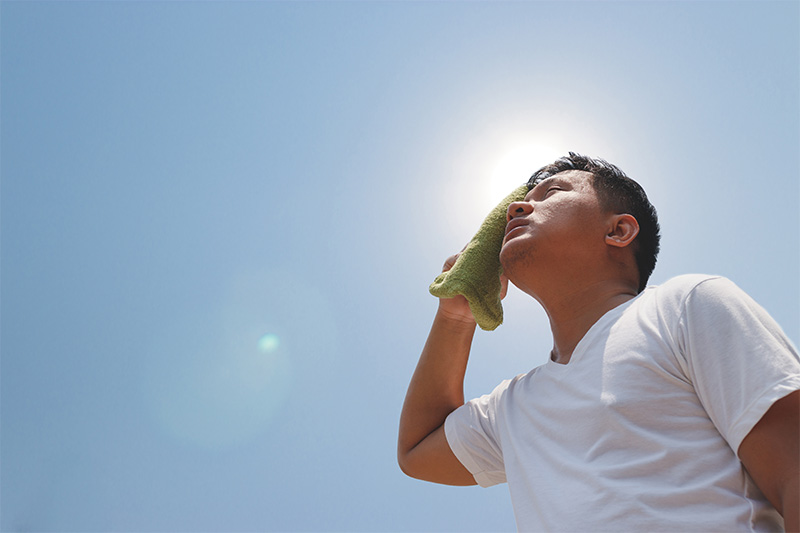What sorts of safety concerns are present at construction sites can be influenced by many things. This includes the time of year. Each season presents its own unique workplace safety risks for construction workers working outdoors. When those risks lead to illness or injury, knowing your rights under workers’ compensation law is just as important as understanding preventative safety practices.
Seasonal Construction Site Hazards
Summer Hazards: Heat-Related Risks
In the summer, the excessive heat the season can bring can create potential safety hazards for construction workers. Such heat could put such workers at risk for conditions such as heat stroke or heat exhaustion.
Heat-related conditions can have major implications for a construction worker’s health. Such conditions can even be deadly. According to the Center for Construction Research and Training, in 2015, heat-related conditions took the lives of 17 construction workers. More recently, OSHA and NIOSH have reported dozens of heat-related fatalities in construction and agriculture each year, proving this risk has not gone away.
Given the significant health implications that heat-related conditions can have, it is essential for construction workers to be aware of the steps they can take to protect themselves from such conditions when working outside during the summer.
One thing they can do on this front is take certain preparations before working in the summer heat. This includes ensuring their clothing is suitable for the prevailing weather conditions. Lightweight, loose-fitting, and light-colored clothes tend to be best for warm-weather conditions.
Another important heat protection step is to ensure that one takes sufficient breaks while working and that these breaks are taken in a cool, appropriately ventilated area.
Additionally, paying careful attention to one’s fluid intake when working outside can help protect against heat. Drinking water regularly is crucial for summer outdoor work. Meanwhile, consuming caffeinated beverages is generally best avoided during such work.
When a construction worker suffers a heat-related illness while doing outdoor work, it is also very important for them to protect themselves. This is their rights related to compensation, such as their workers’ compensation rights. The steps a worker takes on this front could have significant impacts on the type of situation, including financial situation, they end up in following the illness. Workers’ compensation attorneys can provide guidance on measures that can be taken to protect these rights in the wake of a workplace heat-related illness.
Winter Hazards: Cold Stress and Slips
Winter can create very different hazards for construction workers. Cold stress, frostbite, hypothermia, and reduced dexterity are all risks when working in freezing temperatures. Ice and snow increase the chance of slips, trips, and falls, especially on scaffolds, ladders, or rooftops.
Cold weather also creates hidden dangers, such as frozen equipment controls, icy scaffolds, or power tools that malfunction in low temperatures. Employers are expected under OSHA regulations and in California under Cal/OSHA rules to provide insulated clothing, protective gear, and de-icing protocols. Failure to meet these obligations not only puts workers at risk but can also expose employers to penalties and liability.
Spring Hazards: Rain and Mud
Spring often brings heavy rains, flooding, and muddy work sites. This increases the risk of equipment malfunctions, electrical hazards, trench collapses, and slips and falls. Workers may also encounter allergen exposure during peak pollen months, which can affect breathing and visibility.
To prevent injuries, employers should ensure work sites have proper drainage systems, issue protective footwear for muddy conditions, and train workers on how to identify electrical hazards when water is present. Respiratory protection may also be necessary when pollen, mold, or dust are prevalent in the air.
Fall Hazards: Wind and Reduced Daylight
In autumn, shorter daylight hours can affect visibility, while high winds may destabilize cranes, scaffolds, or suspended loads. Construction workers are at greater risk for struck-by accidents and falls during this time.
Employers should plan for changing seasonal conditions by ensuring work sites are properly lit, securing equipment in windy conditions, and providing fall-protection systems when visibility is reduced. Under Cal/OSHA safety orders, employers in California are required to take reasonable steps to anticipate these seasonal risks.
Employer Responsibilities Under OSHA and Cal/OSHA
While workers are encouraged to take precautions for their own safety, the law requires employers to take the lead in protecting employees from environmental hazards. Under OSHA’s general duty clause and specific heat illness prevention campaigns, employers must:
- Provide free and accessible drinking water.
- Allow regular breaks in shaded or cooled areas.
- Offer training on recognizing the signs of heat stress and cold stress.
- Monitor work conditions and adjust workloads in extreme weather.
In California, Cal/OSHA regulations go further, requiring employers in outdoor industries such as construction to develop written heat illness prevention plans, provide immediate first aid, and maintain emergency response procedures. When employers fail to follow these rules, they may be fined and held liable for resulting injuries.
Workers’ Compensation and Legal Rights
Regardless of the season, if a construction worker suffers a heat illness, cold stress injury, fall, or other weather-related construction accident, they may be eligible for workers’ compensation benefits. These benefits may include:
- Payment for all reasonable medical care.
- Partial wage replacement during recovery.
- Disability benefits are available if an injury prevents you from returning to work.
- Survivor benefits for families in tragic fatality cases.
However, claims can be denied if not filed correctly or if the employer disputes the work-related cause of the illness or injury. For example, if an employer claims that heat stroke was caused by a pre-existing condition instead of workplace exposure, the worker may have to fight for coverage.
This is why timely reporting, medical documentation, and legal representation are crucial. At Hussain & Gutierrez, our attorneys understand the complexities of California’s workers’ compensation system. We assist clients with filing initial claims, gathering medical evidence, representing them in disputes with insurance companies, and appealing denied claims.
Frequently Asked Questions
Can I get workers’ compensation for heat stroke on a construction site?
Yes. Heat stroke and other heat-related illnesses are recognized as work-related injuries if they occur while performing job duties. You must report the condition promptly and seek medical care.
What are OSHA’s requirements for heat safety?
OSHA requires employers to provide access to water, rest breaks, shaded or cooled areas, and training on recognizing symptoms of heat illness.
How much water should I drink while working outside in summer?
According to OSHA and NIOSH, construction workers should drink about one cup of water every 15–20 minutes in hot conditions, even if they are not thirsty.
What if my employer failed to provide proper safety gear during extreme weather?
If your employer did not provide adequate protective equipment or ignored OSHA or Cal/OSHA standards, you may have a stronger claim for benefits. An attorney can determine whether additional legal remedies are applicable.
How soon should I file a workers’ comp claim after a weather-related injury?
Deadlines vary by state, but in California, you should notify your employer immediately and file a formal claim within 30 days. Missing deadlines can limit or eliminate your right to benefits.
Protecting Yourself Year-Round
Construction work will always carry risks, but with the right safety practices, employer compliance, and legal protections, workers can reduce dangers and protect their health. Seasonal risks make it even more important to stay informed, take preventative measures, and understand your rights under the law.
If you or a loved one has suffered a heat illness, cold stress injury, fall, or other weather-related construction accident, the law firm of Hussain & Gutierrez can help. Our attorneys are dedicated to protecting injured workers and ensuring they receive the full benefits they deserve.
Contact Hussain & Gutierrez today to schedule a consultation and learn how we can support you through your workers’ compensation claim.



